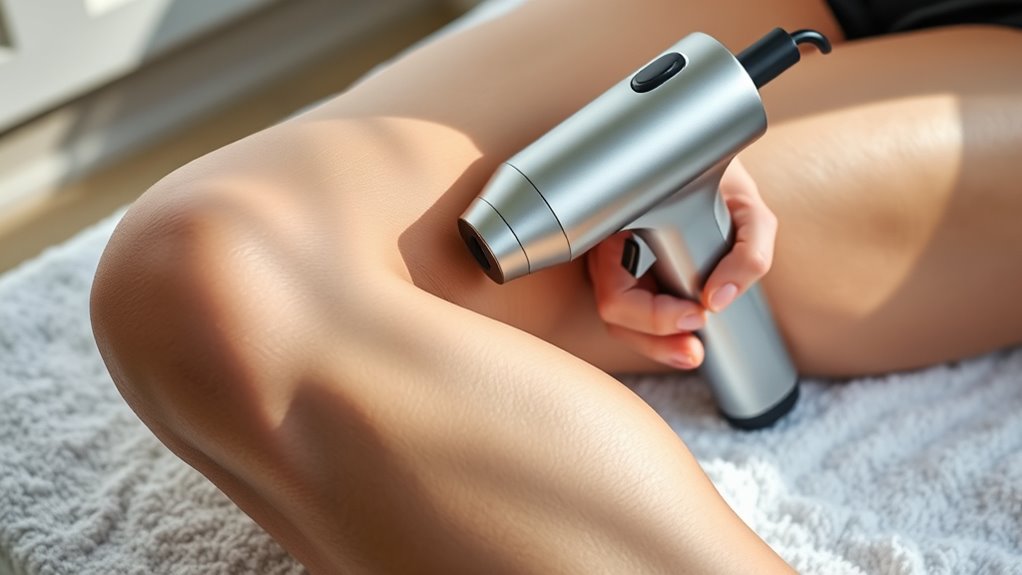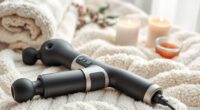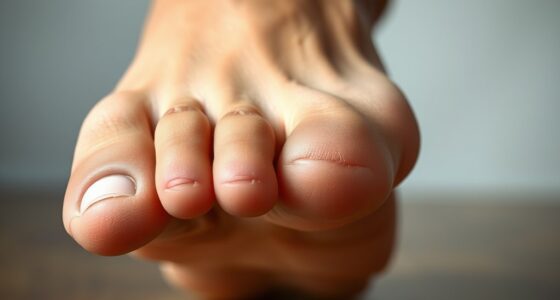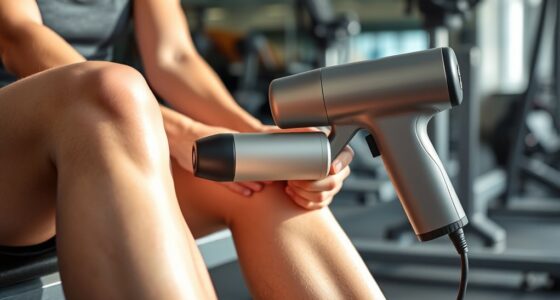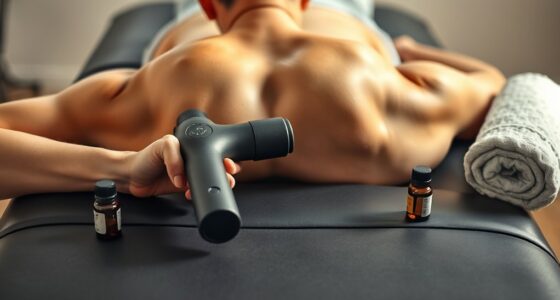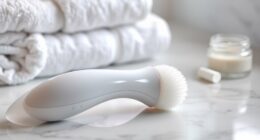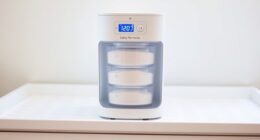To effectively use a massage gun on your knees, focus on the muscles around the joint like your quadriceps, hamstrings, and calves, not directly on the kneecap. Use low to medium settings and gentle, circular motions, moving steadily for 1-2 minutes per muscle. Avoid pressing hard, and always make sure your area is clean. Consistent, proper use can ease soreness and improve circulation—discover more tips as you continue exploring this helpful technique.
Key Takeaways
- Use low to medium settings and avoid applying directly on the kneecap; target surrounding muscles like quadriceps and hamstrings.
- Apply in slow, circular motions, keeping the device moving steadily for 1-2 minutes per muscle group.
- Focus on tense or sore areas to help break adhesions and improve blood flow around the knee.
- Incorporate regular sessions into your routine, especially after activity, for sustained relief and muscle recovery.
- Consult a healthcare professional if knee pain persists or worsens, and avoid applying on inflamed or open areas.
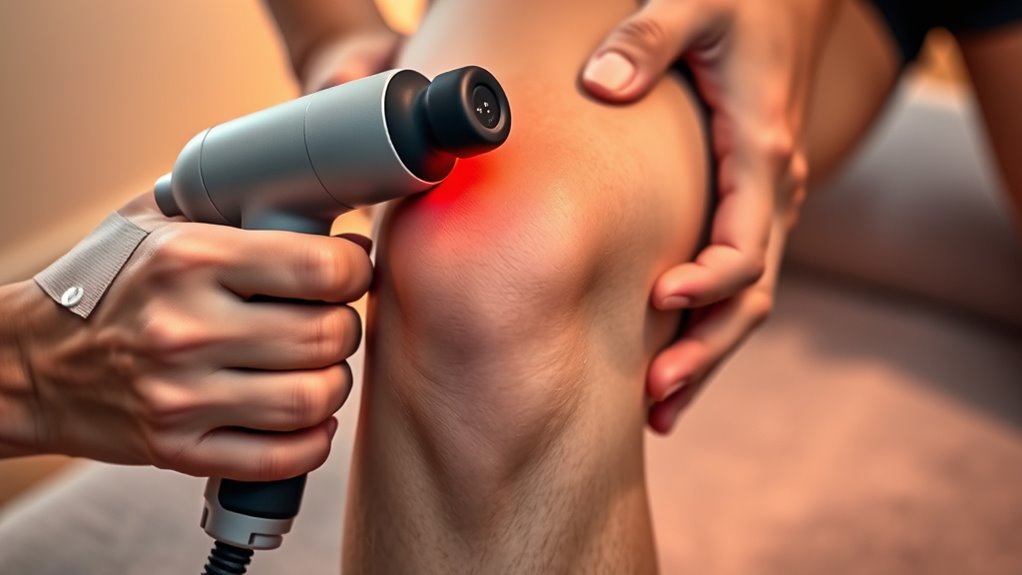
Ever wondered how to ease knee pain effectively? If you’ve been dealing with persistent discomfort, understanding the knee pain causes is a good place to start. Knee pain can stem from a variety of factors—overuse, injury, arthritis, or muscle imbalances—each contributing to inflammation and soreness. Knowing what’s behind your pain helps you target the right treatment, and that’s where a massage gun can really make a difference. The massage gun benefits are impressive: it promotes blood flow, reduces muscle tension, and accelerates recovery, making it an excellent tool for managing knee discomfort.
Understanding knee pain causes helps target effective relief with massage gun benefits.
Using a massage gun on your knees might sound intimidating at first, but when done correctly, it’s safe and highly effective. Before you start, confirm your knee is free of open wounds or severe swelling. Begin by selecting a low to medium setting on your massage gun. Gently place it around your knee area—focusing on the muscles surrounding the joint rather than directly on the kneecap. The quadriceps, hamstrings, and calf muscles often contribute to knee stability and pain, so targeting these areas can help relieve tension that aggravates your discomfort.
When you press the massage gun against your muscles, use slow, circular motions. Keep the device moving steadily to avoid applying too much pressure in one spot, which could cause soreness or bruising. Spend about 1-2 minutes on each muscle group, paying special attention to tense or sore spots. This approach helps break up adhesions, improves circulation, and reduces inflammation, all of which contribute to easing knee pain. Remember not to press too hard—let the massage gun do the work without forcing it into sensitive areas.
The key to maximizing the massage gun benefits is consistency. Incorporate this into your daily routine, especially after activity or prolonged periods of standing, to keep muscles loose and joints supported. Additionally, using a HEPA filter air purifier in your space can help reduce airborne allergens that may exacerbate allergy symptoms or respiratory issues, complementing your overall health routine. Combining massage gun therapy with other knee pain remedies, like stretching and strengthening exercises, can enhance results. If your knee pain persists or worsens, consult a healthcare professional, but for mild to moderate discomfort, this method can be a game-changer.
In short, understanding the knee pain causes helps you tailor your treatment, and using a massage gun the right way can considerably alleviate soreness. It’s a practical, non-invasive option that boosts circulation, relieves muscle tightness, and aids recovery, giving you a better shot at knee pain relief. Just remember to start gently, move steadily, and stay consistent, and you’ll be on your way to healthier knees.
Frequently Asked Questions
Can Massage Guns Permanently Cure Knee Pain?
You might wonder if massage guns can permanently cure knee pain. While they can provide short-term relief and help reduce muscle tension, they won’t offer long-term relief or address underlying issues. Regular use can support injury prevention and improve mobility, but for lasting results, you should also consider proper physical therapy and medical advice. Combining these approaches gives you the best chance for ongoing knee health and pain management.
How Often Should I Use a Massage Gun on My Knees?
Imagine caring for a delicate garden—your knees are just as sensitive. You should follow the frequency guidelines, using your massage gun 2-3 times a week to avoid overwatering or damaging your plants. Always prioritize safety precautions, listening to your body’s signals. Don’t overdo it; too much can cause more harm than good. With patience and proper care, your knees can heal and thrive over time.
Are There Any Risks of Using a Massage Gun Incorrectly?
Using a massage gun improperly can pose risks, so it’s important to follow proper technique and perform a risk assessment beforehand. If you press too hard or stay in one spot too long, you might cause tissue damage or increased pain. Always start with gentle settings, avoid bony areas, and listen to your body. Proper technique minimizes risks and guarantees you get the most benefit from your massage sessions.
Is a Massage Gun Suitable for All Types of Knee Injuries?
You might wonder if a massage gun suits all knee injury types. While it’s great for muscle tension, it’s not compatible with every injury, especially acute or severe ones. For injury types like ligament tears or fractures, consult your healthcare provider first. A massage gun is best suited for muscle-related discomfort, but it’s essential to verify its compatibility with your specific knee injury to avoid further damage.
Can Massage Guns Replace Traditional Physical Therapy?
Using a massage gun is like having a personal muscle recovery coach at your fingertips. While it provides effective pain relief and promotes circulation, it can’t fully substitute traditional physical therapy, which offers targeted exercises and professional guidance. A massage gun is a great supplement for easing soreness, but for serious injuries or chronic issues, you should stick with a healthcare professional’s advice to ensure proper healing and recovery.
Conclusion
Using a massage gun the right way can markedly ease your knee pain, helping you move comfortably again. Did you know that nearly 25% of adults experience knee pain at some point? By applying targeted massage techniques, you can reduce inflammation and boost recovery. Just remember to start gently and listen to your body. With consistent use, you might find yourself saying goodbye to knee discomfort and hello to better mobility.
